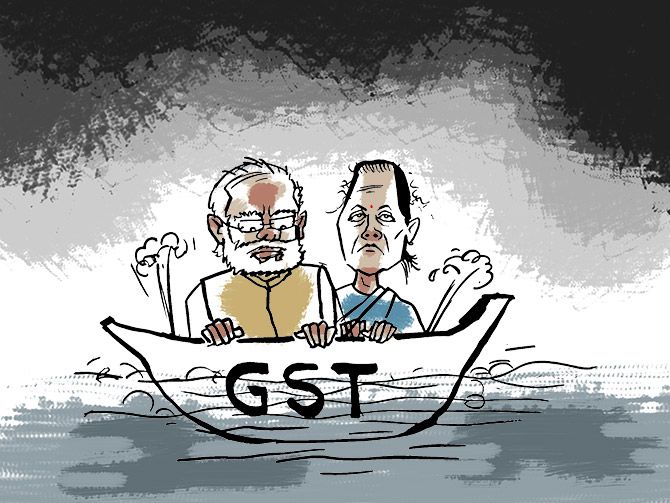'The concept behind GST is that the best and most efficient way to compensate the poor is not through fiddling with indirect taxes but through direct subsidies.
'The government has clearly found good ways to do that, and is proud of its efficiency in delivering subsidies. It should thus abandon its defence of multiple rates, and focus on efficiency and dynamic gains -- which will give it the resources to keep subsidising India’s poor,' says Mihir Sharma.
Illustration: Dominic Xavier/Rediff.com

If there is one original sin that this government has committed, one which lies underneath the extensive economic malaise we see in the economy today, it is how it has failed to properly structure and implement the Goods and Services Tax or GST.
Let us pause to remember what the GST was supposed to be.
It was supposed to be a single-rate tax, which would considerably ease the burden on taxpayers.
It would reduce the paperwork that they have to perform.
A drastic reduction in compliance costs, together with a greater reliance on electronic tracking, would increase compliance.
That, together with the expansion of the tax base and the introduction of taxes on previously excluded items, would raise government revenue permanently.
In addition, the efficiency gains brought in through ending the cascading of tax rates would raise gross domestic product, giving a bump to economic growth and living standards.
Where do we stand today? The most obvious symptom is that GST, as constructed, has under-performed on revenue.
Total revenues were about 1 percentage point of gross domestic product short in the last financial year -- although the Union Budget seemed to want to hide this fact from the public.
This shortfall is almost entirely due to GST bringing in less than was predicted in last year’s Budget.
This is not a small amount. It represents a serious failure.
What has led to this under-performance?
For one, it is likely that evasion is higher than previously envisioned.
This is due to the fact that the construction of the GST depended very heavily on invoice matching.
But the online platform for such matching was so poorly designed, GST itself so complex, that it simply did not eventually implement invoice matching as planned.
This has allowed a cottage industry in fake invoices to build up.
As a result, instead of better compliance through increasing the ease of payment and clever technological solutions, the government is now looking at how to give tax officials ever more power -- the antithesis of what GST was supposed to do.
Another problem: The tax rates. There are too many, and some of them are too low.
We need to be clear about what the revenue-neutral tax rate would have been.
If it is 18 per cent, including alcohol and fuel, then we should have stuck to that.
If we intend to have many goods and services taxed at a lower rate, and if the GST Council spends all its time tinkering with and/or lowering the rates, then we will naturally not make it to our revenue targets.
This is fine if we want to be a low-tax country.
But then we have to acknowledge that we are not seeking revenue neutrality with the implementation of GST.
And we will have to reduce our spending as a consequence.
But that would mean the Indian State would have to change its orientation and make some hard choices.
For example, recognising that one of the biggest spending increases over the past decade has been on paramilitary services, it could perhaps avoid stirring up trouble spots like Kashmir in a manner that will permanently increase spending on security going forward.
Other such behavioural changes might well be required in order to keep the government spending within its considerably reduced means.
What we can’t do is spend as much, tax much less, and then misstate the numbers. Or at least, we can’t do that in any sustainable way.
Here is the central puzzle.
If we are collecting much less GST than we have expected, and if the government is correct that this is due to a reduction in rates rather than anything else, then we have given the public a humongous tax cut.
Where is the spurt in economic activity that should result?
Where are the resurgent animal spirits?
How come this much extra money in the hands of the public is not leading to a consumption boom that stimulates investment in the standard Keynesian manner?
One problem might be that the investment-friendliness of GST is also not achieved.
Many improvements have been made to the requirements for businesses to pay GST, and more are in the pipeline.
This is fortunate. However, I submit that we still have too unpredictable a tax environment to foster investment.
Rates are changed too often -- not just of GST, but also of Customs -- and tax terrorism is a reality.
Tax inspectors have been given too much power in the post-GST era.
These all depress investment below what would otherwise have been its normal level.
An assumed GST bump in economic activity was always dependent on tax becoming less intrusive, not more.
While improvements to the mechanisms of tax payments are planned, perhaps greater ambition is needed.
Essentially, for the vast majority of taxpayers, GST forms should be automatically produced and submitted by multiple third-party invoice and bill settlement apps that can be accessed on mobiles.
If invoice matching is not to be implemented, then we have to go the whole hog in the other direction and make compliance easy using labour-saving technological innovations.
The finance ministry should bring in a wide selection of private sector interlocutors from the financial technology industry to make this happen.
Public consultation on increasing the ease of paying taxes should also be stepped up.
Finally, we have to recognise that we cannot stop our attempt to move towards an ideal GST -- one with a single tax rate, whether revenue-neutral or not.
The government constantly claims that it cannot have high taxes on basic goods.
But the concept behind GST is that the best and most efficient way to compensate the poor is not through fiddling with indirect taxes but through direct subsidies.
The government has clearly found good ways to do that, and is proud of its efficiency in delivering subsidies.
It should thus abandon its defence of multiple rates, and focus on efficiency and dynamic gains -- which will give it the resources to keep subsidising India’s poor.
As we stand today, the government neither has the money for subsidies, nor does the economy have any vim. This is the worst of all worlds.












 © 2025
© 2025